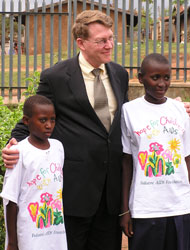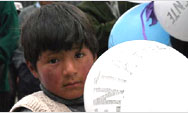Youth
 |
| |
Dr. Kent R. Hill, Acting Assistant Administrator for Global Health, with two children in Uganda. Source: Linda Andrews, PLP |
Today, the growth in the size of young people in the developing world is unprecedented. In 2005, the total number of 10 to 24 year olds was estimated to have reached 1.5 billion, constituting nearly 30 percent of the population in developing countries. Choices made about health-related behaviors and habits adopted during the transition years between childhood and adulthood can have either a positive or negative impact on future health. Given that reproductive health constitute a key component of a healthy transition to adulthood, USAID is making special efforts to improve the reproductive health and HIV/AIDS knowledge and behaviors of the world's youth.
Since 1994, USAID's Office of Population and Reproductive Health (PRH) has assumed a significant technical role in the area of youth reproductive health (YRH). YRH was made into a special initiative in 2001, which continues today as a Global Leadership Priority. Though some consensus has emerged on effective program approaches to YRH, the field is still relatively new with many unanswered questions.
USAID has identified context- and age-appropriate strategies to encourage healthy choices for youth. Accordingly, activities supported by USAID's Youth Working Group encourage abstinence, delay of sexual debut, secondary abstinence (or a return to abstinence), reduction in sexual violence and coercion, and where appropriate, use of contraceptives and condoms. Program emphasis includes "preparatory" tasks that raise awareness of the changes that occur during puberty and promote the development of life skills among girls and boys. In regions where young people marry early, USAID works to provide information, outreach, and services to help delay first birth and space subsequent births, which can decrease the high rates of pregnancy-related morbidity and mortality among adolescent girls. To promote sustainability and institutionalization of YRH activities, USAID and its partners also support policy development, community involvement, and capacity building.
Events
USAID Issue Brief
- Peer Education: A Viable Approach for Reaching Youth - 05/27/08 [PDF, 50KB]
This brief explores peer education as an effective way to improve youth reproductive and sexual health outcomes. Youth peer education programs educate and train motivated young people about reproductive
health and HIV issues to become “peer educators” so they are able to communicate these messages to their peers.
- Youth InfoNet
Family Health International's monthly e-newsletter is a one-stop electronic source for new publications and information on youth reproductive health and HIV prevention.
- Interagency Youth Working Group
The Interagency Youth Working Group (IYWG) seeks to provide global technical leadership to advance the reproductive health and HIV/AIDS outcomes of young people ages 10-24 in developing countries.
- Sakhi Saheli – Promoting Gender Equity and Empowering Young Women [PDF, 3.9MB]
This training manual will benefit those engaged in programs that aim to provide comprehensive gender-based responses to HIV prevention. The manual promotes critical reflection among young women, so they may recognize and understand how gender normative attitudes and behaviors affect their everyday lives and can result in increasing their vulnerability to HIV and other reproductive health problems.
- Growing Up Global [PDF, 730KB]
This prominent study by the National Research Council and Institute of Medicine of the National Academies reviews the research on transitions to adulthood in developing countries, covering a broad range of areas including health, education, employment, and citizenship. The report also provides an analysis of the policy and programmatic implications of this research and partially guides USAID’s programming in YRH.
- Intervention Strategies that Work for Youth [PDF, 321KB]
This publication, addressed to program planners, administrators, policy makers, and donors, reports on evidence-based strategies and programs to promote better health for youth. It focuses on delaying sexual debut, reducing the number of sexual partners, and increasing the use of methods for preventing pregnancy and sexually transmitted infections (STIs), including HIV/AIDS.
- Abstinence and Delayed Sexual Initiation [PDF, 155KB]
This paper promotes abstinence and other complementary messages as important strategies for improving adolescent health.
- Early Marriage and Adolescent Girls [PDF, 143KB]
This paper discusses the health and development risks of early marriage and offers resources on programmatic and policy strategies for addressing the practice.
- Maternal Care among Adolescents [PDF, 148KB]
This paper advocates for increased maternal health services for pregnant adolescents. The paper recommends actions in line with the World Health Organization’s efforts to reduce maternal mortality.
|


